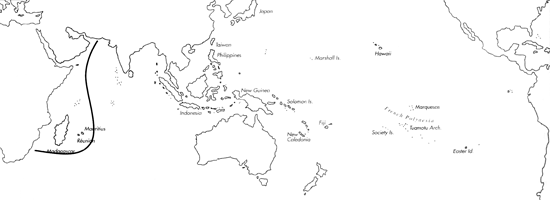Range: Red Sea to Transkei and to Oman.
Description: Medium-sized to large, usually solid. Last whorl conical or ventricosely conical; outline variably convex at adapical fourth to half, straight below; left side slightly concave at base. Shoulder angulate, sometimes subangulate. Spire of low to moderate height, outline usually straight or convex. Larval shell of 2.5-3 whorls, maximum diameter 0.9-1 mm. First 1- 1.5 postnuclear whorl tuberculate. Teleoconch sutural ramps flat to slightly concave, with 0-2 increasing to 4-5 spiral grooves, obsolete in latest whorls. Last whorl with a few weak spiral ribs at base; in subadults, ribs followed by spiral rows of punctations to centre.
| Shell Morphometry | ||
|---|---|---|
| L | 40-100 mm | |
| RW | 0.29-0.80 g/mm | |
| (L 40-88 mm) | ||
| RD | 0.60-0.70 | |
| PMD | 0.80-0.95 | |
| RSH | 0.04-0.14 | |
Last whorl overlaid with brown, orange, yellow or olive or bluish grey, leaving a rather narrow white spiral band at centre and sometimes also at shoulder. Brown or brownish olive axial streaks and blotches intersperse dark areas and often cross white bands. Juveniles may have spirally aligned minute brown dots that become more densely spaced during growth, producing coarse and fine, dotted, dashed or solid lines from base to shoulder; spiral lines sometimes obsolete. Larval whorls yellow. First 2-4 teleoconch sutural ramps yellowish green; following ramps white or bluish grey, with brown or orange brown radial blotches extending to subshoulder area. Aperture bluish violet, usually with white bands at centre and shoulder, becoming almost white during growth.
Periostracum yellowish olive or brown, thin to fibrous thick, translucent to opaque, with spiral rows of tufts on last whorl.
Foot dull yellow, with darker transverse stripes. Siphon brighter yellow (Kohn, unpubl. observ.). Animal dark grey, with grey tentacles and a pale grey tip of siphon (Fainzilber et al., 1992).
Habitat and Habits: Intertidal and subtidal, on sand or muddy sand, on muddy gravel, dead coral heads and on rocks with coralline algal encrustation (Kilburn & Rippey, 1982; Grosch, pers. comm., 1989). In the N. Red Sea, from the outer edge of reed platform to 20 m on sand mixed with coral rubble (Fainzilber et al., 1992)
Discussion: C. namocanus is most similar to C. vexillum, which attains larger size, has about 10 pronounced spiral grooves on the late sutural ramps, a white aperture, and an axially instead of spirally lineate pattern in adults. C. mustelinus and C. capitaneus also resemble C. namocanus but lack the spiral lines on the last whorl, have the white central band prominently edged by dark markings and bear strong spiral grooves on the late sutural ramps. C. capitaneus also differs in its dark brown base, white aperture and its often broader last whorl (RD 0.65-0.75). For comparison with C. trigonus and C. bondarevi see the DISCUSSION of these species. Coomans et al. (1982) considered C. badius (Pl. 23, Fig. 19) a geographic subspecies of C. namocanus from the Red Sea and the Gulf of Aden, differing from the nominal subspecies in its wider shoulder, flatter spire and finer and more numerous spiral lines around the last whorl. However, convincing evidence is lacking to regard it as a representative of the Red Sea population, and the variability in shape and spiral pattern observed in subadult and adult specimens from the Red Sea (cf. Sharabati, 1984) falls within the range of variation in populations outside the Red Sea, e.g. in Kenya and Zanzibar. Distinctively coloured shells from Salalah and Al Masirah, Oman (Pl. 23, Fig. 20), largely agree with C. namocanus in size (L 40- 88 mm), shape (RD 0.60-0.66; PMD 0.84-0.95; RSH 0.04-0.14) and sculpture. They differ in their white apex, pink background on spire, last whorl and within aperture, and in their more reddish brown pattern with spiral lines of larger dots and broader dashes. We consider these differences not to justify a separation at the species level and provisionally assign these shells to C. namocanus. Their status as form of C. namocanus or valid species depends on reliable data on co-occurrence and intergrading with the latter species. We do not accept allocation of these shells to C. luctificus (Coomans & Moolenbeek, 1990). Spiral grooves on sutural ramps are obsolete in the syntypes of C. luctificus, which we consider a synonym of C. fumigatus.

C. namocanus range map
This section contains verbatim reproductions of the accounts of 316 species of Conus from the Indo-Pacific region, from Manual of the Living Conidae, by Röckel, Korn and Kohn (1995). They are reproduced with the kind permission of the present publisher, Conchbooks.
All plates and figures referred to in the text are also in Röckel, Korn & Kohn, 1995. Manual of the Living Conidae Vol. 1: Indo-Pacific Region.
The range maps have been modified so that each species account has it own map, rather than one map that showed the ranges of several species in the original work. This was necessary because each species account is on a separate page on the website and not confined to the order of accounts in the book.